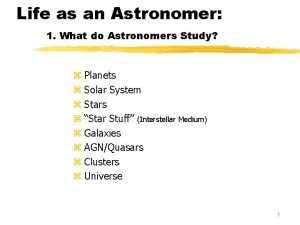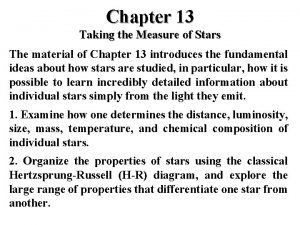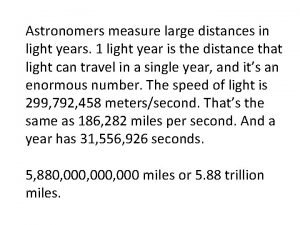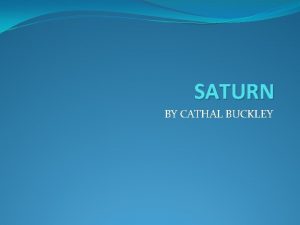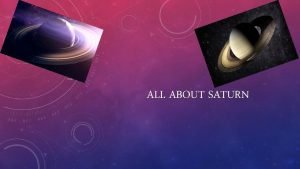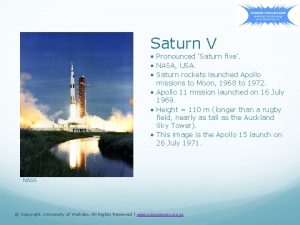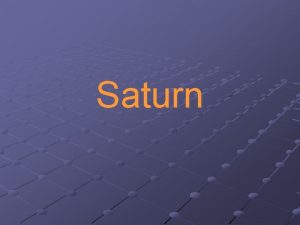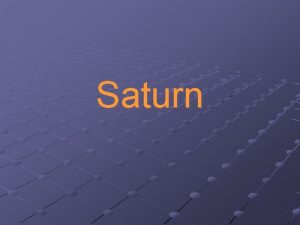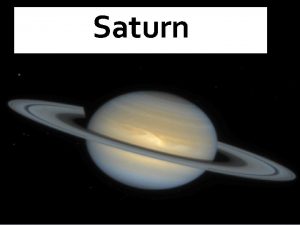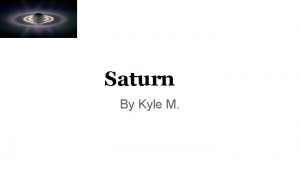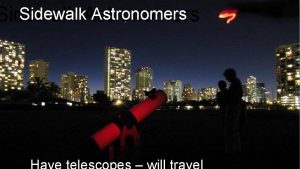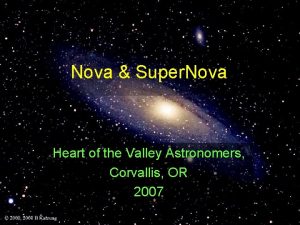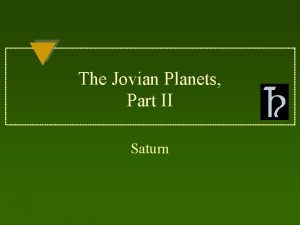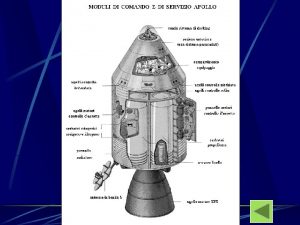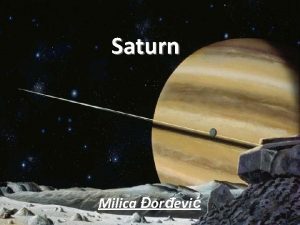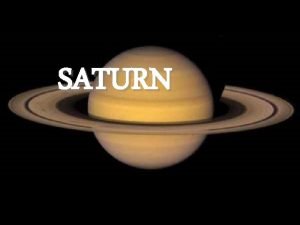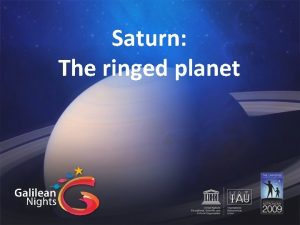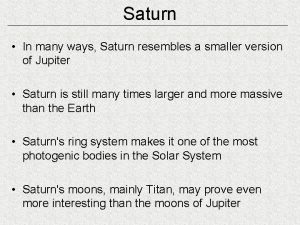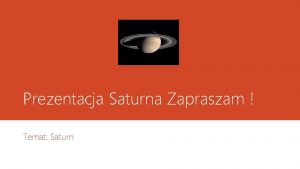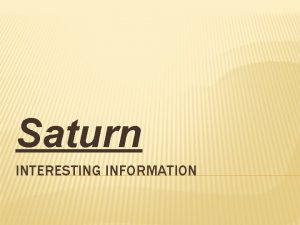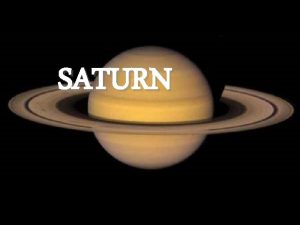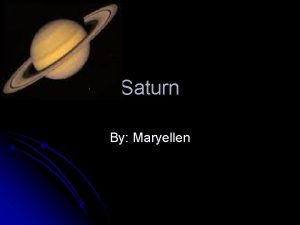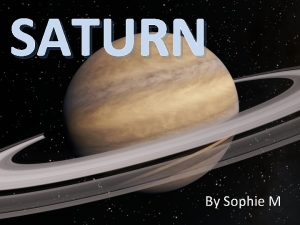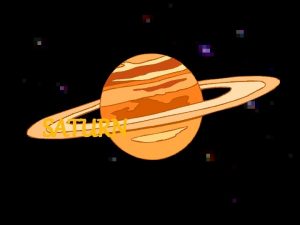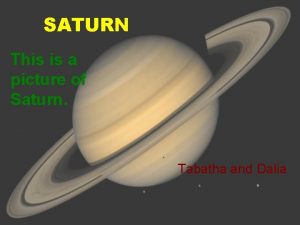Saturn 2007 Heart of the Valley Astronomers Saturn





























- Slides: 29

Saturn 2007 Heart of the Valley Astronomers

Saturn l l l 6 th from Sun; 9. 5 A. U. from Sun This gas-giant is known for its low density. Rings are easily seen in small telescopes.

Saturn in the Solar System’s context

Saturn’s Introduction l l Rotational period differs from equatorial & polar areas 75% hydrogen and 25% helium l l Traces of water, methane, ammonia and silica rock 12, 000+K @ core – where does this originate? l l Heat generated from gravitational compression Possibly more from helium “rain” through lighter H²

How can we generate metallic hydrogen? Light gas gun Reproduced LMH in laboratory conditions (1996) l Temperature at 3, 000+ Kelvin l Pressures of over a million atmospheres l LMH only lasted for a microsecond

Equatorial & polar diameters vary by >10% (75, 335 miles vs. 67, 955 miles)

In addition to weather systems with several-hundred mph winds, Saturn possesses a large magnetic field, resulting in auroras.


Ring Dimensions: Over 150, 000 miles in diameter, but… Width is about 1 km, tops


Moon/Ring interactions


Pan in the Encke Division

Explorations • Saturn orbiter/Titan atmospheric probe. • Launched 1997, arrived at Saturn 2004.

Titan l l l Saturn’s largest moon, with thick nitrogen atmosphere. Heavy clouds prevail. Recently visited by Huygens probe.

Huygens at Titan

Titan’s Atmosphere • 98. 4% N², 1. 6% NH³, & traces of hydrocarbons, Ar, CO², CO, HCN, & He. • Hydrocarbons are thought to form in Titan's upper atmosphere in reactions resulting from the breakup of methane by the Sun's ultraviolet light.

Titan Landforms Surfing, 4 -wheeling, or skiing sites?


Cassini visits Enceladus

Enceladus & geysers

Rhea & Ice impact

Hyperion (!) Chaotic rotation is a distinguishing feature. So is cratered appearance – dark material appears to line bottoms.

Tethys & basin Crater Odysseus is about 250 mi in diameter Ithaca Chasma – 63 mi wide, 2+mi deep, & running over 1, 200 miles.

Personal contemplating


Viewing Saturn remember, it doesn’t take much aperture l l l View well away from Sun Cloud bands are subtle – try locating only when high in sky. Colored filters can help (Wratten 80 a, 47, 25) Colors are subtle but fun to discern Dress appropriately, sit if you can Moon locations – Sky & Telescope magazine or download http: //www. mew 3. com/palm/saturn/doc/ American Association of Lunar & Planetary Observers - http: //www. lpl. arizona. edu/alpo/


Your Thoughts?
 What do astronomers study
What do astronomers study Modern telescopes make it possible for astronomers
Modern telescopes make it possible for astronomers Astronomers measure the masses of stars by
Astronomers measure the masses of stars by Astronomers measure large distances
Astronomers measure large distances Dullness to percussion
Dullness to percussion Sheep heart labeled
Sheep heart labeled Stars plowhorses puzzles dogs
Stars plowhorses puzzles dogs Tư thế ngồi viết
Tư thế ngồi viết Môn thể thao bắt đầu bằng từ đua
Môn thể thao bắt đầu bằng từ đua Bàn tay mà dây bẩn
Bàn tay mà dây bẩn Hình ảnh bộ gõ cơ thể búng tay
Hình ảnh bộ gõ cơ thể búng tay Mật thư tọa độ 5x5
Mật thư tọa độ 5x5 Tư thế ngồi viết
Tư thế ngồi viết Voi kéo gỗ như thế nào
Voi kéo gỗ như thế nào Thẻ vin
Thẻ vin Thơ thất ngôn tứ tuyệt đường luật
Thơ thất ngôn tứ tuyệt đường luật Các châu lục và đại dương trên thế giới
Các châu lục và đại dương trên thế giới Khi nào hổ mẹ dạy hổ con săn mồi
Khi nào hổ mẹ dạy hổ con săn mồi Từ ngữ thể hiện lòng nhân hậu
Từ ngữ thể hiện lòng nhân hậu Diễn thế sinh thái là
Diễn thế sinh thái là V cc cc
V cc cc Vẽ hình chiếu vuông góc của vật thể sau
Vẽ hình chiếu vuông góc của vật thể sau Phép trừ bù
Phép trừ bù Lời thề hippocrates
Lời thề hippocrates Tư thế worms-breton
Tư thế worms-breton đại từ thay thế
đại từ thay thế Quá trình desamine hóa có thể tạo ra
Quá trình desamine hóa có thể tạo ra Công thức tiính động năng
Công thức tiính động năng Thế nào là mạng điện lắp đặt kiểu nổi
Thế nào là mạng điện lắp đặt kiểu nổi
